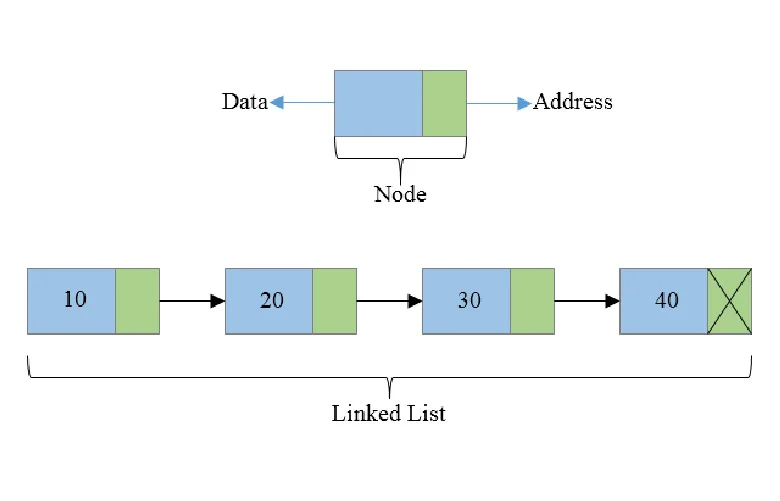A basic data structure called a linked list comprises nodes, or units, with a value and a reference or pointer to the node after it in the chain. Compared to other data structures, the main advantage of a linked list data structure is the effective addition and removal of components from any point in the list. All the information about the linked list in a data structure is included here. The information in the article will flow as follows:
What is a Linked List?
In computer programming, a linked list data structure is a multi-functional data structure that is used to store and manage data collections. It is made out of an arrangement of nodes which are dispersed across the memory.

POSTGRADUATE PROGRAM IN
Multi Cloud Architecture & DevOps
Master cloud architecture, DevOps practices, and automation to build scalable, resilient systems.
Representation of a Linked List
A linked list data structure is often represented as a collection of nodes, each of which houses some data and a reference to the node after it. A linked list’s data must be accessed by starting at the top and working your way down until you reach the required node by following the pointers from node to node.
Properties of Linked List

The main properties of a linked list data structure are mentioned below:
- Dynamic size: Instead of fixed-size arrays, Linked lists can expand or contract as needed while a program is running.
- Effective element insertion and deletion: By simply updating the pointers, linked lists can insert or delete elements from anywhere in the list. There is no constant-time random access to elements in linked lists.
- Sequential access: Linked lists can be used for various activities since they can be sequentially accessed in both the forward and backward directions.
- You can gain extensive information about this by opting for a Business Analytics and Data Science course.
What are The Types of Linked Lists
1.Singly Linked List:
Each node in a single Linked List contains a single pointer that points to the node after it in the list.
2.Doubly Linked List
Each node in a doubly linked list has two pointers, one pointing to the node before it and the other pointing to the node after it.
3.Circular Linked List
A circular structure is produced in a circular linked list when the last node returns to the initial node.

82.9%
of professionals don't believe their degree can help them get ahead at work.
What Are The Operations Supported by Linked List?
The operations supported by the linked list data structure are as follows:
- Insertion
This operation is beneficial for adding a new element to the linked list, which can be done at any position in the list, including the tail or the head.
- Deletion
This operation is beneficial for removing an element from a linked list data structure. This can also be done at any position on the list.
- Display
With this operation, one can visit each element in the linked list in a specific order from head to tail.
- Search
This operation allows one to search for a particular element in the linked list data structure. This can be done by crossing the list and comparing every element to the target.
Applications of Linked List

The linked list data structure is used to work on various computer science and programming projects.
- Implementation of Data Structures: Hash tables, stacks in data structures, and queues are just a few of the significant data structures that may be implemented using the linked list data structures.
- Memory Management: To efficiently allocate and reallocate memory, Linked Lists data structures can be utilised in memory management systems.
- File Systems: File systems can be represented using linked lists data structures. A node represents each file or directory; the links signify the parent-child relationships between the files and directories.
- Graphs and Charts: Graphs can be represented by Linked Lists data structure, where each node is a vertex, and the links are the edges that connect them.
- Making music playlists: Linked List data structures are frequently used to build music playlists. A node represents each song, and the connections between the nodes indicate the order in which the songs are played.
- Picture Processing Method: Picture processing methods can be implemented using linked lists, where a node represents each pixel.
Look here to know more about the Real-time application of data structures.
Uses of Linked List in Data Structure
The main use of a linked list data structure revolves around the storage and organisation of data flexibly and dynamically. It offers effective insertion and deletion operations that can be done constantly, either at the tail or head of the list and also at the linear time in the midst of the list.
Additionally, linked list data structures are essential for implementing other data structures like queues, hash tables, and stacks, among many more. Additionally, linked lists also prove beneficial for representing the hierarchical structure of data, like graphs and trees. If you want to know about Sorting in Data Structures, look here.
Advantages & Disadvantages of Linked List in Data Structure:
The advantages offered by linked list data structure are as follows:
- Dynamic size: At runtime, linked lists can change their size.
- Effective insertion and deletion: Inserting or removing elements from a list’s centre may be done quickly and efficiently with linked lists.
- Memory efficiency: linked lists don’t require contiguous memory allocation.
- Flexibility: Linked lists offer a lot of versatility.
Along with the advantages, some disadvantages linked list data structure offers:
- Sequential access: Linked lists have poor cache locality and significant memory overhead.
- Absence of random access: As linked lists cannot use random access, accessing entries directly from an index is impossible.
- Complexity: The implementation and upkeep of linked lists can be more difficult than those of arrays.
Conclusion:
Programmers choose Linked Lists because of their adaptability and simplicity and because of their dynamic character, which enables them to change to accommodate new situations. Numerous varieties suit various demands, ranging from single-linked lists to circular and doubly-linked lists.
What are the applications of a linked list?
What are the different types of linked lists?
- Singly Linked List
- Doubly Linked List
- Circular Linked List
- Skip List
- Self-Organising List
Why use a linked list over an array?
- Dynamic Size: Linked Lists data structures, instead of Arrays, can be resized dynamically at runtime, making them more adaptable.
- Effective Insertion and Deletion: Effective insertion and deletion operations as linked lists simply need to update the pointer instead of rearranging the entries as they would in an array.
- No Wasted Memory: Linked Lists assign only the memory necessary to retain the actual data, eliminating wastage.
- Simple to Implement: Unlike Arrays, Linked List data structures are easier to implement and require less memory management.
What are the 3 subtypes of linked list data structure?
- Singly Linked List Data Structure: A singly linked list has a single pointer that points to the following node in the list at the end of each node's data element.
- Doubly Linked List Data Structure: Each node in a doubly linked list has a data element and two pointers, one pointing to the node after it in the list and the other pointing to the node before it.
- A Circular Linked Data Structure: This may help implement a circular buffer or a round-robin scheduling mechanism
Is the linked list dynamic or static?
Updated on March 19, 2024
